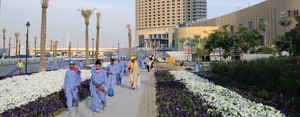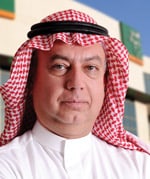SEEKING MORE-INCLUSIVE GROWTH
By Gordon Platt
After strong economic growth in 2011, the six nations of the Gulf Cooperation Council are spreading the wealth by putting a priority on non-oil job creation and social welfare.
 |
| Photo Credit : PHILIP LANGE / Shutterstock.com |
Strong oil demand from emerging markets is fueling growth in the six Gulf Cooperation Council countries, and this trend looks set to continue for some years to come. Real economic growth in GCC countries will remain high over the next few years because of strong demand for energy from emerging markets, according to resaerch from Standard & Poor’s. GCC countries possess 40% of the world’s proven oil and gas reserves, and a majority of the region’s exports are destined for Asia. Non-oil GDP growth is expected to be strong in all GCC countries this year, as they continue to diversify and create jobs for their rapidly growing populations.
More than 70% of GCC exports are destined for Japan and the developing countries of Asia. With all of its nuclear reactors now offline, Japan’s reliance on fossil fuel has soared, according to analysts at Barclays Capital. Of Japan’s 54 commercial nuclear reactors, few were operational as of May, 14 months after the Great East Japan Earthquake. Before the earthquake, Japan generated one-third of its electricity from nuclear power stations and had plans to increase it to 50%.
“The GCC economies appear well positioned to benefit from the upward trajectory of oil prices that we foresee over the next five years,” says Jean-Michel Six, S&P’s chief economist for Europe, the Middle East and Africa. “Their market share in emerging markets, where most of the incremental demand for oil will come from, is bound to consolidate their strong current account position, a key strength at a time when demand for funding on international debt markets becomes more competitive.”
Meanwhile, these countries face demographic challenges that can only be met through continuous efforts to diversify their economies away from hydrocarbons, Six cautions in a recent report. More than half of the GCC population is below the age of 30, and the population has grown at an average annual rate of 4.2% over the past decade, while the labor force has expanded by an average 3% a year.
Most GCC governments recognize the need to encourage the shift of the national workforce from the public sector to the private non-oil sector, Six says. The oil sector is more capital-intensive than labor-intensive. About 90% of nationals in the United Arab Emirates and 55% in Saudi Arabia are employed in the public sector, where wages are generally higher and social benefits are more attractive.
SAUDI WINDFALL
 |
|
Al Halabi, NCB Capital: Disruptions in global oil markets allowed Saudi Arabia to boost production |
Saudi Arabia saw a sharp acceleration in growth last year. Jawdat Al-Halabi, CEO of NCB Capital, notes: “Disruptions in the global oil market allowed Saudi Arabia to boost its production, while prices remained at historically high levels,” he says. “This fiscal windfall, in turn, supported a shift to much more inclusive growth, prioritizing such areas as job creation, housing and social welfare.” Combined with a government emphasis on infrastructure, education and health care, this led to a strong one-off increase in government spending, he notes.
Saudi Arabia’s non-oil economy grew 8.5% last year, the highest rate in more than 30 years, according to Masood Ahmed, director of the Middle East and Central Asia Department at the International Monetary Fund. The overall Saudi economy grew by 7.1% in 2011 and is forecast to expand by 6% this year. “Reflecting prudent economic management, the economy is likely to remain buoyant,” he says. “Targeted government investment alongside product and labor-market reforms can facilitate a more dynamic private sector and stimulate job creation for [Saudi] nationals.”
Al-Halabi says there is positive momentum in non-oil private sector growth. “Many of the positive developments in areas such as education and the development of small and medium enterprises have the potential to create a virtuous cycle.”
ROBUST ISLAMIC FINANCE
Islamic finance performed better than conventional banking during the financial crisis and is contributing to stability in the region. “Arguably, the main liability of conventional financing during the recent crisis was its heavy and growing reliance on leverage, amplified by the widespread use of complex structures,” Al-Halabi says. “Islamic finance has built-in defense mechanisms against such weaknesses.”
Islamic finance also benefited from its comparative newness and its heavy presence in high-growth emerging markets, according to Al-Halabi. “This made for a more benign economic environment, but also for relatively less-sophisticated financial markets and stricter regulations.” He notes that some Islamic financial institutions got into trouble by being overexposed to real estate markets, but regulators have responded to this risk.
There have been a number of important sukuk issuances lately. “The market seems to have shaken off the worst problems associated with opaque structures and default-type situations, and we now have much greater clustering around generally accepted structures,” Al-Halabi says. Sukuk yields are historically low, indeed lower than those for conventional bonds, he adds. “Most issuers in the sukuk space tend to be high-quality corporates,” he says.
Another major opportunity for the region is the rise of project sukuk. The Saudi government, for one, has indicated that it favors sovereign-guaranteed issues for revenue-generating projects—particularly after the success of the General Authority for Civil Aviation’s sukuk for the King Abdulaziz Airport in Jeddah, which was launched in January. Private-sector companies are also exploring project sukuk, which promise to create a bridge between the large pools of capital in the region and the massive pipeline of infrastructure investments.
RIPE FOR INVESTMENT
GCC countries are ripe for foreign direct investment in a number of sectors, with huge capital-spending and infrastructure development projects now under way.
Vipin Sher, VP finance and business development at Praxair Middle East, notes: “Some $2 trillion of projects have been planned or are under way in the region, which is the equivalent of the GDP of several countries combined.”
Praxair, one of the world’s largest producers of industrial gases, is rapidly expanding its GCC operations. “We did an in-depth analysis and identified the Gulf as a region with a lot of potential for growth because of diversification out of oil and government plans to invest in infrastructure and upgrade operations,” says Sher.
These developments require industrial gases, Sher says. In August 2010, Praxair purchased a 49% stake in the ROC Group’s industrial gas production and distribution operations in three countries from the Al-Khaled family of Kuwait. “We are focusing on GCC countries because of their low-cost feedstock and low-cost fuel costs, which means that they can produce low-cost steel, glass and cement, as well as petrochemicals.”



